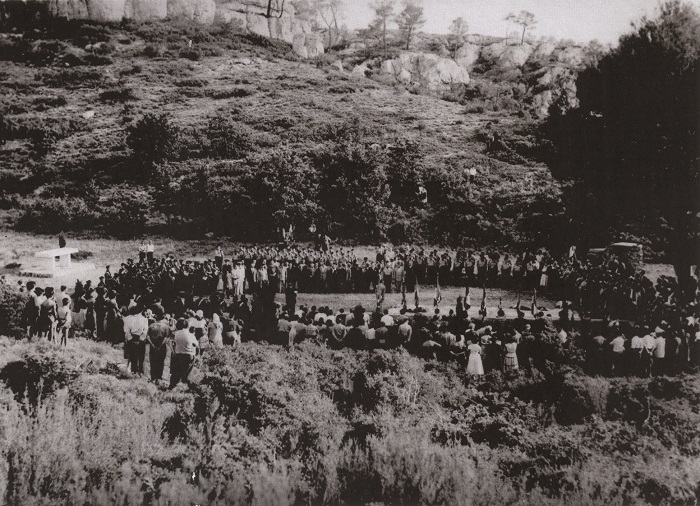The Resistance in the southern zone
In the summer of 1940, individuals and small groups protested against the Occupation and criticised the political orientations of the newly established French State. Gradually, movements and networks of resistance developed in unoccupied Provence, as in the rest of the country.
In November 1942, the Germans crossed the demarcation line and invaded the Free Zone. The Resistance was reinforced with new members and developed armed operations against the Occupier.
On 26 January 1943, on the initiative of Jean Moulin, the three main movements in the southern zone (Combat, Libération Sud and Franc Tireur) joined forces to become Mouvements Unis de la Résistance (MUR). They established a highly structured underground organisation comprising various different branches, including the Armée Secrète (AS), Noyautage des Administrations Publiques (NAP), Recrutement-Organisation-Propagande (ROP) and Organisation Universitaire (OU). In mountainous areas, where many took refuge from compulsory labour service (STO), maquis (rural resistance groups) were formed, issuing from the MUR, FTP (Francs-Tireurs et Partisans) or ORA (Organisation de Résistance de l’Armée). Between December 1943 and February 1944, the various armed forces of the Resistance came together to form the Forces Françaises de l’Intérieur (FFI).
In 1944, the Resistance in the southern zone prepared to liberate the territory. Departmental Liberation Committees (CDLs) were set up. Following the Allied landings in Normandy on 6 June 1944, repression by the German Army, the Gestapo and the Milice was stepped up, particularly against the maquis founded in June in the Provence region.
The executions of July and August 1944
In summer 1944, a betrayal led to the arrest by the Gestapo of large numbers of Resistance members in the R2 region (present-day Provence-Alpes-Côte d’Azur). These included, on 16 July 1944, the vast majority of members of the Comité Départemental de Libération des Basses-Alpes, who were gathered in Oraison. Others were called in for questioning or paid a visit at their homes. After being subjected to interrogation and torture at the Gestapo headquarters in Marseille, 425 rue Paradis, they were transferred to Les Baumettes prison.
On 18 July, after a sham trial, 29 of these men were killed by firing squad in an isolated valley in the Signes woods. On 12 August, nine others were executed on the same site. The bodies were buried where they lay.
The discovery of this mass grave in September 1944 revealed the brutality of the executions: some were buried alive and quicklime was scattered on the bodies, making some of them unrecognisable. Among the victims, it was possible to identify members of the various Resistance movements and organisations, including the chairman of the Basses-Alpes Departmental Liberation Committee (CDL), several members of the Mouvements Unis de Résistance (MUR), Organisation Universitaire (OU) and Noyautage des Administrations Publiques (NAP), the head of the French Forces of the Interior (FFI) for Region 2, the Regional Military Delegate (DMR), young officers of the Free French Forces (FFL), a member of the British Special Operations Executive and a US officer.
In the Signes woods, the Nazis inflicted heavy losses on the Provençal Resistance, depriving it, on the eve of the Provence landings, of a number of its leaders.
On 21 September 1944, a national funeral was held at Saint Pierre cemetery in Marseille, presided over by Raymond Aubrac, then regional Commissioner of the Republic, and attended by civilian, military and religious leaders. Since then, on 18 July each year, a ceremony has been held in this “Valley of the Martyrs” turned national cemetery, in memory of those 38 members of the Resistance who were executed here.

Ceremony of 18 July 1945. Chiny collection
Those executed at Signes
44, headmaster – CDL Basses-Alpes
45, broker– departmental head, AS Bouches-du-Rhône
37 ans – Lieutenant FFI
40, sales representative – France au Combat
59, lawyer – France au Combat
29, teacher – regional head, OU
30, French officer – head of inter-Allied mission (acting DMR)
36, head of farming cooperative – SAP Basses-Alpes
34, highways authority engineer – regional head, NAP
55, inspector-general, PTT – regional head, NAP-PTT
29, philosophy teacher – CDL Basses-Alpes
44, doctor – doctor, FFI Basses-Alpes
49, decorator – MLN
32, doctor – British SOE
19, student – OU
27, town hall secretary – CDL Basses-Alpes
44, head mechanic – NAP SNCF
29, French officer – ORA
41, painter – CDL Basses-Alpes
20, student – OU
32, adman – intelligence agent, OSS
20 – head of MLN liaison service
22, student – OU
46, head of cooperative – leader, MLN, and chairman, CDL Basses-Alpes
45, entrepreneur – head, NAP Bouches-du-Rhône
34, US officer – Inter-Allied Mission, OSS
30, French officer – sector commander, AS Marseille
31, French officer – FFL
23, French officer – BCRA, FFL
39, nurse – CDL Basses-Alpes
28, mechanic – agent, FTP Basses-Alpes
31, French officer – regional head, FFI
20, student – FFI (Robert Rossi’s secretary)
18, student – agent, FTP Basses-Alpes
44, notary – OU